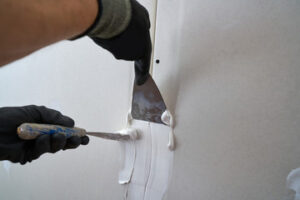Why Drywall Repair Is Necessary
Drywall is a tough material, but holes can still happen. They can be caused by anything from a wayward doorknob or hammer to a rambunctious kid. While homeowners can do small drywall repairs, large ones require professional help from Drywall Repair Las Vegas. Here are some tips on drywall repair to keep in mind. Drywall seams and joints crack because the drywall is subject to movement from various factors. This includes environmental conditions (such as a home left vacant for long periods) and foundation problems.
 Usually, the cracks are harmless, though some can be a sign of something more serious. For example, if vertical cracks run at an angle or are wider than a quarter inch, the crack may indicate that the foundation has shifted or that there is water damage in the building. Most drywall cracks can be repaired quickly, inexpensively and safely by re-taping the joint. This will reinforce the surface, reducing the likelihood of the crack reappearing.
Usually, the cracks are harmless, though some can be a sign of something more serious. For example, if vertical cracks run at an angle or are wider than a quarter inch, the crack may indicate that the foundation has shifted or that there is water damage in the building. Most drywall cracks can be repaired quickly, inexpensively and safely by re-taping the joint. This will reinforce the surface, reducing the likelihood of the crack reappearing.
Drywall is a solid, durable material that’s used in the construction of walls. However, drywall can also become damaged by nails or other objects that puncture it. The result can be an unattractive or even dangerous hole in the wall.
Repairing holes in drywall can be tricky and requires a lot of know-how and tools. Large holes, for example, are difficult to fix by hand and require professional repair. The first step is to clean the area of drywall debris and dirt. This will help prevent a patch from sticking to the wall and creating an uneven repair. After sanding the damaged area, use a putty knife to fill in the hole. Then, spread a thin layer of joint compound over the patch.
For smaller holes, about the size of a doorknob, you can use a patch kit that comes with a mesh patch. These patches are self-adhesive, so you place them over the hole and cover it with joint compound. Sagging is a common problem with drywall. It can be caused by a number of factors, including poor construction, undersized drywall and water damage. A good first step is to see if the drywall used is the correct size. While 1/2″ drywall is very popular, it’s a little light and won’t be as sturdy as 5/8″ thick drywall.
Another potential cause of sagging is termites. They’ll eat through the supporting ceiling joists, weakening them and exerting more force on the drywall below. This is a big problem because termites can be hard to spot and are typically found in older homes.
Other issues contributing to drywall sagging include water damage, leaks, earthquakes and poor construction. In addition, sagging can be the result of seasonal temperature changes. This is something that should be addressed in your upcoming home inspections. Having a professional inspect your home before any repairs are made will prevent problems in the future and save you money in the long run.
Drywall is a common type of building material, and it has many advantages over other options. For example, it aids in fire protection and mildew prevention.
However, it is also susceptible to water damage from hidden leaks. It is very important to identify the source of water damage and call for professional drywall repair services.
When a water-related issue is not addressed quickly, mold will begin to grow on the drywall in just 24 to 48 hours. In addition, the spores will spread throughout the entire home or commercial property.
This can result in a variety of health issues for the residents or employees of the affected area. These problems can range from allergy symptoms to asthma and even respiratory diseases.
Drywall repair refers to the process of fixing or replacing damaged sections of drywall, which is a common material used to construct interior walls and ceilings in homes and buildings. Damage to drywall can occur due to various reasons, such as holes, cracks, dents, water damage, or mold.
The process of drywall repair involves identifying the damaged area, cutting out the damaged section of drywall, and replacing it with a new piece. The new piece of drywall is then secured in place, typically with screws or adhesive, and then taped, mudded, and sanded to create a smooth, seamless finish.
Drywall repair can be a relatively simple task for minor damage, such as small holes or cracks. However, larger or more complex repairs may require the skills of a professional contractor. Hiring a professional can ensure that the repair is done correctly, matches the existing texture and finish of the surrounding area, and prevents further damage or issues in the future.
